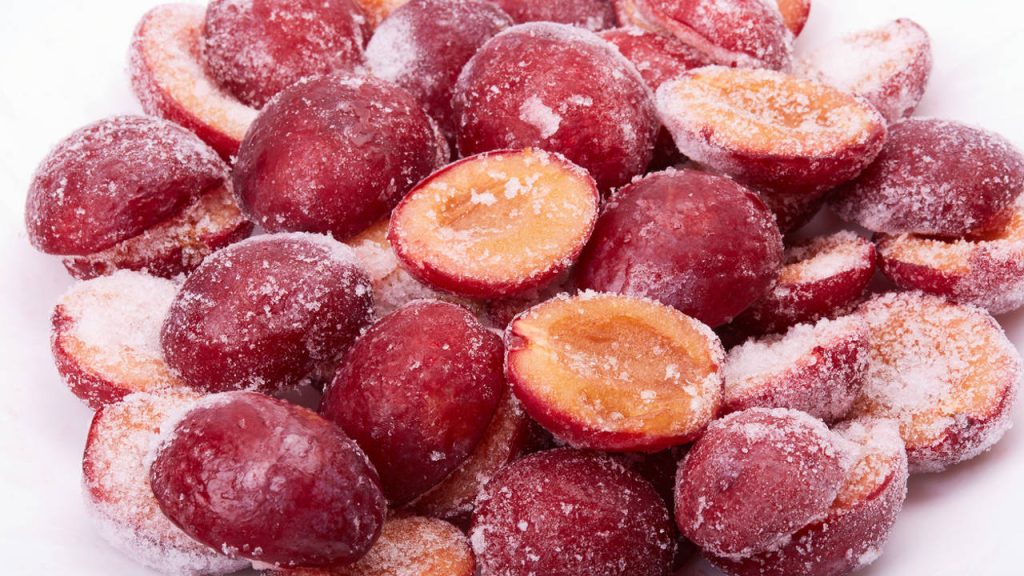Stone fruits not only taste delicious, but they are also very healthy. If this summer you are harvesting more plums or cherries than you can consume, you can simply freeze the fruit. We explain how to do it

Plums, cherries, apricots, peaches, and nectarines are stone fruits because they have a juicy pulp and a single woody core. Some of the fruits are in season until late summer.
Stone fruit should not be stored for a long time. It is better to consume or process it as soon as possible.
If you want to enjoy stone fruits even out of season, you can extend their shelf life. Many fruits can last up to a year frozen. But what should you keep in mind when freezing this type of fruit?
FREEZE PLUMS
Plums are booming in late summer. If you have picked a particularly large amount of fruit from the trees, or want to take advantage of an offer you can simply freeze them and use them later.
It is best to use pieces that are fully mature but do not yet have bruises.
The freezing process is simple:
- Carefully remove leaves and stems.
- Wash the plums well with water.
- Dry them with a tea towel.
- Cut the fruit in half with a sharp kitchen knife and remove the bones. If you skip this step, boning later will be tedious.
- In a first step, freeze the separated halves into trays. After four hours, gather all the halves in the container with a lid that you will leave in the freezer.
Frozen plums have a shelf life of at least six months. It is not advisable to reach the year in the conservation time.
HOW DO YOU THAW FROZEN PLUMS?
Defrost the plums slowly and gently in the refrigerator before using them to make jam or plum compote, for example.
If you plan to bake a plum cake, you can place the fruit directly on the cake without thawing it.
FREEZING CHERRIES
If there is an abundant harvest of cherries, it is worth freezing the fruit. Ripe and dark cherries are especially suitable for this, since even after thawing they still have a very sweet taste. It is important that the cherries are not overripe or bruised.
For cherries you can do the following:
- Wash the cherries thoroughly, preferably in a sink filled with water.
- Let the fruits dry completely. If you are in a hurry, you can dry the fruit by gently tapping with a tea towel.
- Remove the stems, but not the seeds. Otherwise, the cherries will lose their flavor and become mushy after thawing.
- To refreeze, line a large plate with baking paper and place the cherries on top so they don’t touch. This way they will not freeze forming a dough later.
- Freeze the cherries on a tray for an hour or two and then transfer them to a freezing container. Cherries will last between ten and twelve months in the freezer.
HOW ARE CHERRIES THAWED?
If you want to thaw the cherries, it is best to store them in the refrigerator overnight. Alternatively, you can thaw the fruit at room temperature for a few hours. Then they should be easy to remove and process to get cherry jam, cherry juice or a delicious dessert.
FREEZE APRICOTS
If you want to freeze apricots, you can do the same thing you did with plums. Mature specimens that have a beautiful golden yellow color and no spots are best suited for this purpose.
- Carefully clean and dry the apricots.
- Cut them in half and place them individually on a plate. Pre-put baking paper underneath.
- Drizzle the fruits with a little lemon juice; This will prevent them from turning brown quickly.
- Let the apricots pre-freeze for an hour or two. Then transfer the fruit to a frozen container.
- Frozen apricots remain edible for about nine months.
HOW ARE APRICOTS THAWED?
To thaw, it is best to put the apricots in the refrigerator for a few hours. Next, the fruit halves should be left at room temperature for a while.
Keep in mind that apricots don’t develop their full aroma when it’s cold. You can also top a cake directly with frozen apricot halves.
FREEZE PEACHES
There’s a little more to consider when freezing peaches. Above all, it is important to remove the hairy peel from the fruit before freezing it. Otherwise, the skin would release bitter tastes into the pulp. In addition, frostbite hardens the skin a lot.
If you want to freeze peaches, the best way to do it is:
- Using the tip of a knife, make a cross at the base of the peaches.
- Blanch the fruit in boiling water for 30 to 60 seconds.
- Now you can remove the skin easily with a kitchen knife.
- Cut the peaches in half and remove the pit.
- If you want to bake a cake, cut the fruit into slices. To make peach compote it is advisable to cut the fruit into pieces.
- Sprinkle lemon juice on the fruit to prevent it from turning brown.
- Put the fruit in a bowl and freeze. If it is important that the fruits can be taken out individually, you need to put them back on a plate, freeze them quickly for an hour or two, and then transfer them to a common container.
- Frozen peaches have a shelf life of eight to twelve months. However, you should not wait too long before consuming them, as the fruits significantly lose their aroma after a year at most.
If you want to thaw the peaches, we recommend placing the fruit in a colander at room temperature and collecting the fruit juice.
FREEZING NECTARINES
When freezing nectarines, choose only fresh fruits with smooth and intact skin. You can do the same as with plums. That means:
- Wash and dry the nectarines thoroughly.
- Cut the fruit in half and remove the pit.
- Optionally (depending on the intended use) cut it into small pieces.
- Place the halves or pieces of fruit on a plate lined with baking paper and freeze them for an hour or two.
- Then transfer to a frozen container.
- Frozen nectarines stay fresh for at least four to six months. You can use them to make compotes, jams or smoothies








